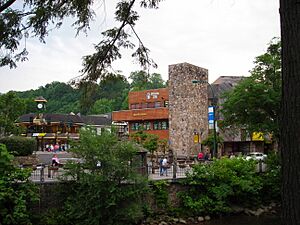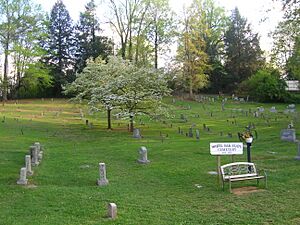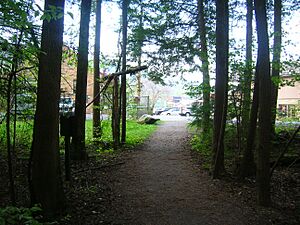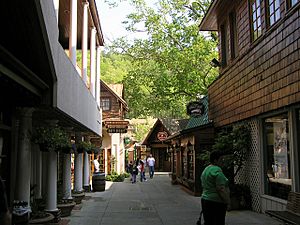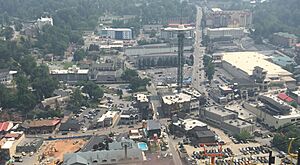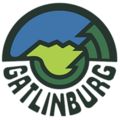Gatlinburg, Tennessee facts for kids
Quick facts for kids
Gatlinburg
|
|||
|---|---|---|---|
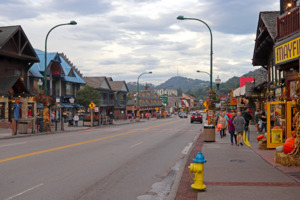
US 441 in downtown Gatlinburg c. 2018
|
|||
|
|||
| Nickname(s):
"Gateway to the Great Smoky Mountains"
|
|||
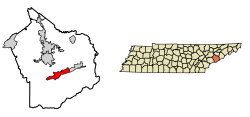
Location of Gatlinburg in Sevier County, Tennessee
|
|||
| Country | United States | ||
| State | Tennessee | ||
| County | Sevier | ||
| Settled | c. 1806 | ||
| Incorporated | 1945 | ||
| Named for | Radford Gatlin | ||
| Government | |||
| • Type | City Manager-Commission | ||
| Area | |||
| • Total | 10.41 sq mi (26.97 km2) | ||
| • Land | 10.41 sq mi (26.97 km2) | ||
| • Water | 0.00 sq mi (0.00 km2) | ||
| Elevation | 1,450 ft (440 m) | ||
| Population
(2020)
|
|||
| • Total | 3,577 | ||
| • Density | 343.48/sq mi (132.61/km2) | ||
| Time zone | UTC−5 (EST) | ||
| • Summer (DST) | UTC−4 (EDT) | ||
| ZIP code |
37738
|
||
| Area code(s) | 865 | ||
| FIPS code | 47-28800 | ||
| GNIS feature ID | 2403685 | ||
Gatlinburg is a mountain resort city in Sevier County, Tennessee. It is located about 39 miles (63 km) southeast of Knoxville. In 2020, its population was 3,577 people.
Gatlinburg is a very popular vacation spot. It sits right next to the Great Smoky Mountains National Park. U.S. Route 441 runs through the city and connects it to Cherokee, North Carolina. Before it became a city, it was known as White Oak Flats.
Contents
History of Gatlinburg
Early Settlers and the Ogle Family
For many centuries, Cherokee hunters used a path called the Indian Gap Trail. This trail helped them find lots of animals in the Smoky Mountains. Today, US-441 follows much of this old trail.
The first person to plan on settling permanently in the area was William Ogle (1751–1803). He came from South Carolina. With help from the Cherokee, Ogle cut logs to build a cabin. He went home to get his family and supplies. Sadly, he died in 1803 from a sickness.
His wife, Martha Huskey Ogle (1756–1827), moved her family to Virginia. Around 1806, Martha and her family traveled to what is now Gatlinburg. William Ogle's cut logs were still there. They built a cabin near Baskins Creek. This cabin still stands in Gatlinburg today.
Many more settlers moved to the area in the years that followed. Most of them were soldiers from the American Revolutionary War or the War of 1812. They received land for their service.
How Gatlinburg Got Its Name
In 1856, a post office opened in Radford Gatlin's general store. This is how the town got the name "Gatlinburg." Radford Gatlin (c. 1798–1880) had moved to the area around 1854.
However, Gatlin often argued with his neighbors, especially the Ogle family. By 1857, they had a big disagreement. Gatlin was a supporter of the Confederate side during the U.S. Civil War. Most people in Gatlinburg supported the Union. Because of these disagreements, Gatlin was forced to leave in 1859.
Gatlinburg During the Civil War
Gatlinburg tried to stay neutral during the Civil War. But this changed when Confederate soldiers came to protect saltpeter mines nearby. Union forces marched from Knoxville to drive them out. The Confederates had built a small fort on Burg Hill.
A local woman, Lucinda Oakley Ogle, shared what her grandfather remembered. He said he would hide and watch the Union soldiers shoot their cannons at the Confederate fort. The Confederate soldiers were outnumbered. They had to retreat across the Smokies to North Carolina. After this, Confederate forces did not return to Gatlinburg.
Growth in the Early 1900s
In the 1880s, new tools like the bandsaw and logging railroads made the lumber business boom. Lumber companies started cutting down trees deeper in the Appalachian mountains. In 1900, Andrew Jackson Huff (1878–1949) built a sawmill in Gatlinburg. Local people started renting rooms to loggers and other lumber workers.
Tourists also began to visit the Smokies. They were drawn by writers who described the beautiful nature of the region.
In 1912, a women's group called Pi Beta Phi started a school in Gatlinburg. It is now called Arrowmont School of Arts and Crafts. They found that the town really needed better education. The school taught children and also helped local people sell their handmade crafts.
The National Park Arrives
Cutting down so many trees led to calls for protecting the forests. In 1911, a law was passed to buy land for national forests. People started pushing for a national park in the Smokies, like Yellowstone. In 1926, a large area of land was bought, and the idea became real.
Andrew Huff helped lead this effort in Gatlinburg. He opened the first hotel in town, the Mountain View Hotel, in 1916. His son, Jack, built LeConte Lodge on top of Mount Le Conte in 1926. Even with some challenges, Great Smoky Mountains National Park opened in 1934.
The park completely changed Gatlinburg. In 1912, Gatlinburg was a tiny village with only six houses. In 1934, the park's first year, about 40,000 visitors came through the city. A year later, this number jumped to 500,000! Land prices in Gatlinburg soared.
While the park brought a lot of money to Gatlinburg, it also caused problems. These included air quality issues and too much building. Even today, the town's roads and services can get very busy on peak vacation days.
Fires in Gatlinburg
The 1992 Fire
On July 14, 1992, a large fire destroyed a whole city block in Gatlinburg. It started because of bad wiring in a light. The Ripley's Believe It or Not! museum burned down, along with an arcade and souvenir shops. Firefighters stopped the blaze before it reached the nearby Gatlinburg Space Needle. The area was rebuilt and reopened in 1995. This fire led to new building rules and a new fire station downtown.
The 2016 Wildfires
In November 2016, a wildfire started in the Great Smoky Mountains National Park. Very strong winds and dry weather caused it to spread quickly into Gatlinburg and nearby towns. Many people had to leave their homes. The center of Gatlinburg's tourist area was mostly saved. However, the surrounding wooded areas were badly damaged.
About 14,000 people were evacuated. More than 2,400 buildings were damaged or destroyed. The fires caused over $500 million in damages. Sadly, fourteen people died. After the fires, Gatlinburg was closed for a short time. It reopened to residents first, then to the public.
Historic Places in Gatlinburg
- First Methodist Church, Gatlinburg: This church was designed in a style called Late Gothic Revival.
- Settlement School Community Outreach Historic District: This area includes buildings from the school started by Phi Beta Pi in 1912. It has the Jennie Nicol Health Clinic, the Arrowcraft Shop, and the Ogle Cabin.
Geography and Climate
Gatlinburg covers about 10.1 square miles (26.2 km2) of land. It is surrounded by tall mountains and ridges. The main river is the West Fork of the Little Pigeon River. It flows from Mount Collins to Sevierville.
U.S. Route 441 is the main road through Gatlinburg. It runs north to south through the middle of town. Pigeon Forge is about 6 miles (9.7 km) north. The Great Smoky Mountains National Park is about 2 miles (3.2 km) south.
Weather in Gatlinburg
Gatlinburg has a humid subtropical climate. This means it has hot, humid summers and cool, wet winters. It rains a lot throughout the year, especially from May to July. October is usually the driest month. The valley gets about 8 inches (20 cm) of snow each year.
| Climate data for Gatlinburg, Tennessee, 1991–2020 normals, extremes 1921–present | |||||||||||||
|---|---|---|---|---|---|---|---|---|---|---|---|---|---|
| Month | Jan | Feb | Mar | Apr | May | Jun | Jul | Aug | Sep | Oct | Nov | Dec | Year |
| Record high °F (°C) | 81 (27) |
85 (29) |
86 (30) |
93 (34) |
98 (37) |
106 (41) |
105 (41) |
100 (38) |
102 (39) |
94 (34) |
85 (29) |
80 (27) |
106 (41) |
| Mean maximum °F (°C) | 68.9 (20.5) |
71.8 (22.1) |
79.0 (26.1) |
85.6 (29.8) |
86.6 (30.3) |
89.5 (31.9) |
90.8 (32.7) |
90.0 (32.2) |
88.0 (31.1) |
82.0 (27.8) |
75.8 (24.3) |
69.7 (20.9) |
92.1 (33.4) |
| Mean daily maximum °F (°C) | 46.6 (8.1) |
50.8 (10.4) |
59.2 (15.1) |
68.8 (20.4) |
74.8 (23.8) |
80.2 (26.8) |
82.9 (28.3) |
81.9 (27.7) |
77.5 (25.3) |
68.5 (20.3) |
58.1 (14.5) |
49.5 (9.7) |
66.6 (19.2) |
| Daily mean °F (°C) | 36.6 (2.6) |
39.9 (4.4) |
46.9 (8.3) |
55.4 (13.0) |
62.8 (17.1) |
69.5 (20.8) |
72.8 (22.7) |
71.8 (22.1) |
66.8 (19.3) |
56.4 (13.6) |
45.9 (7.7) |
39.5 (4.2) |
55.3 (12.9) |
| Mean daily minimum °F (°C) | 26.6 (−3.0) |
28.9 (−1.7) |
34.6 (1.4) |
42.0 (5.6) |
50.9 (10.5) |
58.7 (14.8) |
62.7 (17.1) |
61.6 (16.4) |
56.1 (13.4) |
44.2 (6.8) |
33.7 (0.9) |
29.4 (−1.4) |
44.1 (6.7) |
| Mean minimum °F (°C) | 8.2 (−13.2) |
13.3 (−10.4) |
19.9 (−6.7) |
27.6 (−2.4) |
36.0 (2.2) |
48.0 (8.9) |
54.9 (12.7) |
53.3 (11.8) |
43.1 (6.2) |
29.4 (−1.4) |
21.0 (−6.1) |
15.4 (−9.2) |
5.4 (−14.8) |
| Record low °F (°C) | −18 (−28) |
−13 (−25) |
−6 (−21) |
16 (−9) |
26 (−3) |
33 (1) |
43 (6) |
40 (4) |
27 (−3) |
15 (−9) |
2 (−17) |
−12 (−24) |
−18 (−28) |
| Average precipitation inches (mm) | 4.75 (121) |
4.27 (108) |
5.58 (142) |
4.93 (125) |
5.50 (140) |
5.99 (152) |
6.31 (160) |
4.40 (112) |
4.34 (110) |
3.19 (81) |
4.02 (102) |
4.92 (125) |
58.20 (1,478) |
| Average snowfall inches (cm) | 2.4 (6.1) |
2.4 (6.1) |
1.3 (3.3) |
0.0 (0.0) |
0.0 (0.0) |
0.0 (0.0) |
0.0 (0.0) |
0.0 (0.0) |
0.0 (0.0) |
0.0 (0.0) |
0.2 (0.51) |
1.4 (3.6) |
7.7 (20) |
| Average precipitation days (≥ 0.01 in) | 15.1 | 14.5 | 14.7 | 12.5 | 14.8 | 15.1 | 15.4 | 13.8 | 10.9 | 9.9 | 11.6 | 15.2 | 163.5 |
| Average snowy days (≥ 0.1 in) | 2.0 | 1.7 | 0.9 | 0.0 | 0.0 | 0.0 | 0.0 | 0.0 | 0.0 | 0.0 | 0.2 | 1.0 | 5.8 |
| Source: NOAA | |||||||||||||
Population of Gatlinburg
| Historical population | |||
|---|---|---|---|
| Census | Pop. | %± | |
| 1950 | 1,301 | — | |
| 1960 | 1,764 | 35.6% | |
| 1970 | 2,329 | 32.0% | |
| 1980 | 3,210 | 37.8% | |
| 1990 | 3,417 | 6.4% | |
| 2000 | 3,382 | −1.0% | |
| 2010 | 3,944 | 16.6% | |
| 2020 | 3,577 | −9.3% | |
| Sources: | |||
Gatlinburg's Population in 2020
| Race | Number | Percentage |
|---|---|---|
| White (non-Hispanic) | 2,735 | 76.46% |
| Black or African American (non-Hispanic) | 15 | 0.42% |
| Native American | 13 | 0.36% |
| Asian | 71 | 1.98% |
| Pacific Islander | 4 | 0.11% |
| Other/Mixed | 104 | 2.91% |
| Hispanic or Latino | 635 | 17.75% |
In 2020, Gatlinburg had 3,577 people living in 1,742 households. There were 1,012 families.
Gatlinburg's Population in 2010
In 2010, Gatlinburg had 3,944 people. Most residents (85.3%) were White. About 15% of the population was Hispanic or Latino.
About 22.8% of households had children under 18. The average household had 2.33 people. The average family had 2.8 people. The median age in the city was 44.7 years old.
The average income for a household in Gatlinburg was about $36,445. About 15% of the population lived below the poverty line.
Economy and Tourism
Gatlinburg is a very important place for tourism in Tennessee. It has many fun attractions. The Gatlinburg Trolley is a public transportation system for visitors. The Gatlinburg SkyLift takes people 1,800 feet (550 m) up Crockett Mountain. From there, you can walk on the longest footbridge in the US.
Ober Mountain is the only ski resort in Tennessee. It has eight ski trails and a wildlife area. You can get there by road or by a special tramway.
The Gatlinburg Space Needle offers amazing views of the Smoky Mountains.
The Gatlinburg Arts and Crafts Community is an 8-mile (13 km) loop. It focuses on keeping traditional mountain crafts alive.
The Ripley's attractions include Ripley's Aquarium of the Smokies. They also have other themed exhibits.
Theme parks like Dollywood and Dollywood's Splash Country are in nearby Pigeon Forge. These parks are named after singer Dolly Parton.
Gatlinburg also has interesting museums, like the Museum of Salt and Pepper Shakers.
The downtown area of Gatlinburg uses numbered intersections. These numbers are on traffic lights and tourist maps. This helps visitors find their way around easily.
During the Christmas season, downtown Gatlinburg is decorated with many lights. This is part of the "Winterfest Celebration."
Gatlinburg is a popular place for weddings and honeymoons. This is because it is easy to get a marriage license in Tennessee.
The town is even mentioned in the famous Johnny Cash song, A Boy Named Sue.
Gatlinburg Convention Center
The Gatlinburg Convention Center has over 67,000 square feet (6,200 m2) of space for events. It hosts the annual Gatlinburg Regional, which is a very large bridge tournament. Over 3,000 players come to this event.
Law Enforcement
The Gatlinburg Police Department, also known as "GPD," is the main police force in Gatlinburg. It has 45 officers and 10 support staff. The department is large for a small town. This is because so many tourists visit the area every year.
Notable People from Gatlinburg
- Felice and Boudleaux Bryant: These two were a songwriting team. They lived in Gatlinburg and wrote many songs, including "Rocky Top."
- Travis Meadows (born 1965): He is a country music singer and songwriter. He wrote songs for famous stars like Eric Church. Meadows started his songwriting career while living in Gatlinburg.
- John Reagan (1818–1905): Born in Gatlinburg, Reagan later moved to Texas. He became a politician and served in the U.S. House of Representatives and U.S. Senate. He also worked for the Confederate States of America.
Images for kids
See also
 In Spanish: Gatlinburg para niños
In Spanish: Gatlinburg para niños







